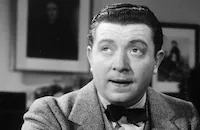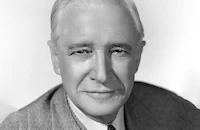The House on 56th Street

Brief Synopsis
Cast & Crew
Robert Florey
Kay Francis
Ricardo Cortez
Gene Raymond
John Halliday
Margaret Lindsay
Film Details
Technical Specs

Synopsis
At the turn of the century, Peggy Martin, a beautiful show girl, is the mistress of Lindon Fiske, but she is in love with the handsome young Monte Van Tyle. The young couple marry against his family's will, make their home on 56th St., have a child and are reconciled there with Monte's family. They are happy until Fiske, now ill, comes back into Peggy's life. When she refuses his advances, he threatens to commit suicide and although she tries to stop him, the gun goes off. She is accused of murder and sentenced to twenty years in prison. While Peggy is in jail, Monte is killed in World War I, and their daughter Eleanor is told that her mother is dead. Shortly after Peggy is released, she meets a gambler named Bill Blaine. They go to work for Bonelli, a New York politician who has opened a gambling house in Peggy's old home on 56th St. One night Eleanor visits the house, having inherited her mother's flair for gambling. Peggy decides to teach Eleanor a lesson and makes sure she does not win, but when Blaine calls Eleanor into his private office and threatens to inform her husband about her sizable debts, Eleanor shoots him. Peggy protects the girl by confessing to the crime. Bonelli, however, suspects the truth and offers to clear her, if she agrees to stay permanently in the house on 56th Street.

Director

Robert Florey
Cast

Kay Francis

Ricardo Cortez

Gene Raymond

John Halliday

Margaret Lindsay

Frank Mchugh

William Boyd (stage)

Sheila Terry

Hardie Albright

Phillip Reed
Phillip Faversham

Henry O'neill

Walter Walker

Nella Walker

Samuel Hinds
Theodore Newton
Helen Raclay
Renee Whitney
Pat Wing
Lorena Layson
Crew
Howard Bretherton
W. S. Brown
Leo F. Forbstein
Ellsworth Fredericks
Sheridan Gibney
Ernest Haller
Esdras Hartley
William Keighley
Earl Luick
Keefe Maley
Emily Moore
Orry-kelly
Austin Parker
Joseph Santley
Russ Saunders
James Seymour
Dudley Slausson
Charles Scott Welbourne

Photo Collections
Videos
Movie Clip


Trailer
Film Details
Technical Specs

Articles
The House on 56th Street
As Jeanine Basinger wrote in her book on the genre, A Woman's View, "When one thinks of fashion and glamour, Kay Francis should be the standard by which everything else is measured. Sitting on-screen, as she does at the end of The House on 56th Street (1933), wearing a stark evening gown and dealing blackjack with a grace and style that have long since disappeared from American movies, she is the absolute personification of what fashion and glamour meant to the woman's film of the 1930s." (And as Variety tersely put it in its review: "Women will like it.")
It's no accident that the film's title puts the house front and center. Like Rebecca (1940), The Enchanted Cottage (1945), Enchantment (1948) and other movies, The House on 56th Street features a house not only as a character in the story but as a metaphor for, and reflection of, its principal character. Kay Francis (who took the role after Ruth Chatterton turned it down) plays a 1905 chorus girl who marries a rich gentleman (Gene Raymond) much to the consternation of his family, who deem her unsuitable. But she wins them all over, transforming herself into a society woman, and she and Raymond move into the beautiful house of the title, which he promises will be hers forever. Since this is a melodrama, a crazy turn of events soon lands Francis in prison for 20 years, and when she is released in the middle of the jazz age -- with no husband, no house, and no connection to a daughter (Margaret Lindsay) who has grown up without her -- she must start from scratch. She falls in with a gambler (Ricardo Cortez), transforms herself yet again into a modern fashion queen, and amazingly finds herself back at the house on 56th Street... but in a new, far different way than before. And all along, the look and condition of that house have also changed over and over again.
Basinger argues that the house in a woman's film is often used to define the woman's world, and this picture is no different -- in fact it is more powerful than most in that the "definition" keeps changing during the story: "The house...is at first Kay Francis's dream, then her nightmare and trap, and then her solace. It represents every step of her career in terms of society's approval."
For director Robert Florey, The House on 56th Street was his favorite among the films he directed at Warner Bros. in the 1930s. (He moved to Paramount in 1935.) Florey was especially keen about recreating the New York of 1905 in the first part of the film, which he said was based on the lives of the Florodora Sextette, the chorus girls in the famous Broadway musical Florodora. While Warners gave this picture a big budget and approved the creation of intricate costumes and decor, Florey's zest for detail did lead to a clash with production chief Hal Wallis, who told the director in a memo, "Let's not overdo the wardrobe just because we are in a period." According to author Brian Taves, this penchant for accuracy, which the studio saw as wasteful spending, would keep Florey from being assigned to many more period films.
Florey remains an underrated director from the era, and throughout The House on 56th Street he employs intelligent and imaginative use of sound and montage to create heightened emotional impact, especially in sequences like Francis's release from prison -- in which she sees the new, modern New York City and is flabbergasted at the difference from 1905 -- and a honeymoon montage that's brief yet highly evocative of each place that's visited. The entire film packs more narrative into its brief running time than anyone should have a right to expect.
The House on 56th Street was shot in 28 days in the summer of 1933. Audience ovations at previews persuaded the studio to hold release until the lucrative Christmas season, and it opened that December, indeed becoming a sizable hit.
Many believe this touching, poignant film contains Kay Francis's finest performance. She certainly is called upon to portray a huge range of emotions -- and of course ages, since the story spans 25 years. Francis herself quipped at the time, "If it does better than my other films, it's because I parade thirty-six costumes instead of sixteen."
Director: Robert Florey
Screenplay: Austin Parker, Sheridan Gibney (screenplay); Joseph Santley (story)
Cinematography: Ernest Haller
Art Direction: Esdras Hartley
Music: Bernhard Kaun (uncredited)
Film Editing: Howard Bretherton
Cast: Kay Francis (Peggy Martin Van Tyle/Peggy Stone), Ricardo Cortez (Bill Blaine), Gene Raymond (Monty Van Tyle), John Halliday (Lyndon Fiske), Margaret Lindsay (Eleanor Van Tyle Burgess), Frank McHugh (Chester Hunt), William Boyd (Mr. Bonelli), Hardie Albright (Henry Burgess), Sheila Terry (Dolly, a Sextet Girl), Phillip Reed (Freddy).
BW-69m. Closed Captioning.
by Jeremy Arnold
Sources:
Jeanine Basinger, A Woman's View: How Hollywood Spoke to Women 1930-1960
Scott O'Brien, Kay Francis: I Can't Wait to be Forgotten -- Her Life on Film and Stage
Lawrence J. Quirk, The Great Romantic Films
Brian Taves, Robert Florey, The French Expressionist

The House on 56th Street
Quotes
Trivia
Notes
According to Warner Bros. records, Adolphe Menjou was initially cast as Blaine; this was to be his first film for Warner Bros. He was then put into Convention City and replaced by Ricardo Cortez who was borrowed from Paramount.















